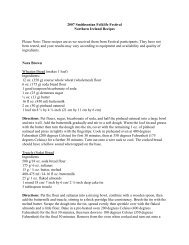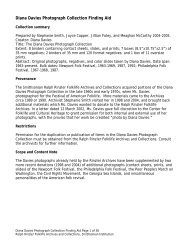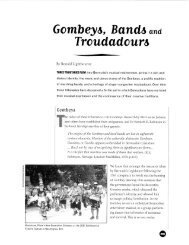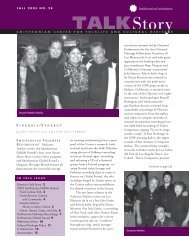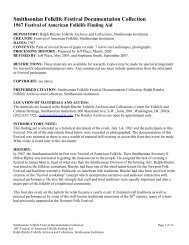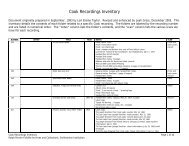Who Owns Traditional Medical Knowledge? - Smithsonian Center ...
Who Owns Traditional Medical Knowledge? - Smithsonian Center ...
Who Owns Traditional Medical Knowledge? - Smithsonian Center ...
You also want an ePaper? Increase the reach of your titles
YUMPU automatically turns print PDFs into web optimized ePapers that Google loves.
162 SITA REDDY<br />
tional remedies, efforts to propertize ethnomedicine have taken the forefront among<br />
heritage initiatives worldwide. Indigenous activists and state actors now routinely<br />
make cultural claims to possess or repossess medical and botanical knowledge,<br />
while global anxiety over cultural appropriation in this field is so widespread that<br />
it even has a name: biopiracy. And yet TMK remains one of the most difficult<br />
categories to regulate within the intangible cultural heritage discourse. As a concept<br />
that straddles bioresources and folkloristic healing, trade discussions and biodiversity<br />
conservation, botanical knowledge and indigenous rights, TMK must<br />
respond to diverse legal instruments and ethical codes and thus often falls between<br />
the cracks in policy and practice.<br />
This paper describes the ambiguities, problems, and unintended consequences<br />
in the process of making medical heritage legible. I rely here on James Scott’s theoretical<br />
framework of state practices in Seeing Like a State, which outlines legibility—<br />
“efforts to settle mobile subjects and to simplify complex knowledge”—as the central<br />
and perennial problem of statecraft, particularly in the organization of the natural<br />
world. 1 Following recent United Nations (UN) legal conventions that redefine medical<br />
heritage as a form of collective property belonging not to a global commons<br />
but to nation-states 2 , or as a form of intangible cultural heritage that must be<br />
documented before it can be protected, 3 state-based heritage protection schemes<br />
focused on medical knowledge often begin with cultural documentation: namely,<br />
the attempt to publicize and codify traditional knowledge, pharmacopeia, and healing<br />
practices, through inventories, databases, texts, and archives in order to claim<br />
ownership over them. 4<br />
As Michael Brown and other anthropologists have noted, however, the very process<br />
of making knowledge legible contains inherent paradoxes. Redefining TMK as<br />
a proprietary resource often ends up removing it from the public domain in an attempt<br />
to return it to its alleged creators. This process relies on globalizing Information<br />
Society models to make TMK public, but in effect protects it from<br />
globalization or at least from the cultural and information flows that result from<br />
globalization. 5 Databases of traditional knowledge, such as India’s TKDL, are particularly<br />
instructive examples of this paradox. Created to fend off foreign patents on<br />
what they define as a nation’s heritage, they bear the simultaneous burden of proving<br />
that a proposed innovation has been part of the public domain for centuries, but<br />
do so by asserting ownership over it, which directly conflicts with their appeals to a<br />
universal public domain. 6 <strong>Medical</strong> heritage schemes may rely on a premise of cosmopolitan<br />
ownership, the claim that heritage belongs to the world; but as Marilyn<br />
Strathern notes, they often work in practice to reinscribe cultural boundaries, and<br />
to “re-embed or recontextualize indigenous ownership in traditional knowledge.” 7<br />
A second paradox of legibility has to do with what legal scholars call the hyperownership<br />
of an increasingly contested biological commons: a situation in which<br />
state-based systems of ownership push the boundaries of sovereignty so far in unleashing<br />
a spiral of enclosures that they risk creating new property claims, new<br />
subjects, and the possibility of an anticommons. 8 Making heritage legible can cut



